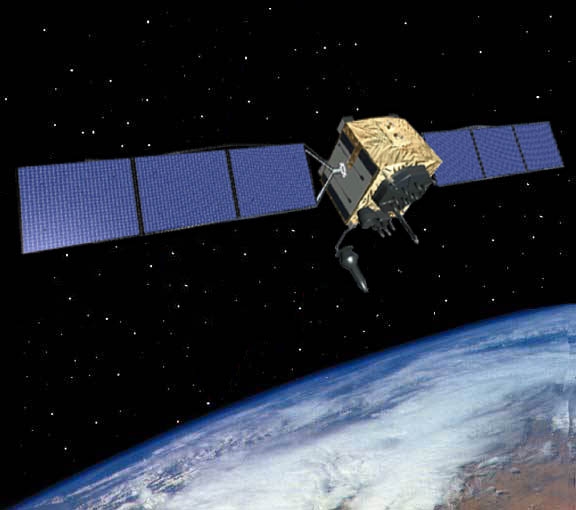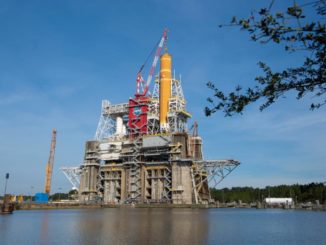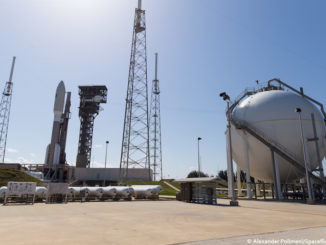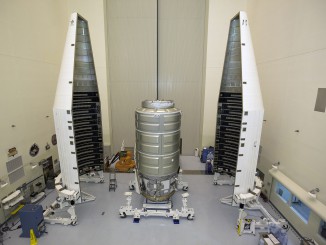CAPE CANAVERAL — The Global Positioning System, its precision navigation and timing services made possible by the U.S. Air Force and provided free-of-charge to the planet’s civilian population, is a marvel of the modern world, and the orbiting network will receive a fresh satellite Wednesday.
The $245 million GPS 2F-10 satellite is scheduled for liftoff from Cape Canaveral aboard a United Launch Alliance Atlas 5 rocket during an available launch opportunity that extends 18 minutes from 11:36 to 11:54 a.m. EDT.
Weather forecasters are predicting a 70 percent chance of meeting the launch rules.
“We stand ready to launch the 10th GPS 2F satellite,” said Col. Michael Rokaw, Global Positioning Systems Directorate’s Space Systems Division chief.
“It will add new capability and provide better accuracy to the users of GPS.”
Rising away from Complex 41, the 189-foot-tall rocket will follow a 46-degree flight azimuth to the northeast en route to replace a retiring 19-year-old satellite in the GPS constellation.
The two-stage vehicle will deliver the 3,400-pound satellite into an 11,000 nautical mile circular orbit, tilted 55 degrees to the equator. It should take 3 hours and 23 minutes to get there.
Atlas 5 rockets will launch this satellite as well as the next two in October and January. Those three deployments will complete the Boeing-built GPS Block 2F satellite series that has offered greater accuracy, more signals, better anti-jamming and longer design lives.

The 12-satellite Block 2F project began launching in 2010 to form the backbone of the GPS fleet for the next 15 years.
GPS 2F-1: May 27, 2010 (Delta 4) Plane B, Slot 2
GPS 2F-2: July 16, 2011 (Delta 4) Plane D, Slot 2A
GPS 2F-3: Oct. 4, 2012 (Delta 4) Plane A, Slot 1
GPS 2F-4: May 15, 2013 (Atlas 5) Plane C, Slot 2
GPS 2F-5: Feb. 20, 2014 (Delta 4) Plane A, Slot 3
GPS 2F-6: May 16, 2014 (Delta 4) Plane D, Slot 4
GPS 2F-7: Aug. 1, 2014 (Atlas 5) Plane F, Slot 3
GPS 2F-8: Oct. 29, 2014 (Atlas 5) Plane E, Slot 1
GPS 2F-9: March 25, 2015 (Delta 4) Plane B, Slot 1F
GPS 2F-10: Wednesday (Atlas 5) Plane C, Slot 3
GPS 2F-11: October (Atlas 5)
GPS 2F-12: January (Atlas 5)
Atlas will push through Mach 1 in 78 seconds and the region of maximum air pressure at 91 seconds, as the RD-180 main engine consumes kerosene fuel and supercold liquid oxygen.
Approaching booster engine cutoff four minutes into flight, the vehicle is burning propellants at a rate of 1,600 pounds per second, weighing only a quarter of what it did at liftoff before the first stage separates and the Centaur lights.
It is a lengthy first firing of Centaur that parallels the eastern seaboard and flies above the North Atlantic, putting the vehicle into a preliminary orbit of 11,000 by 90 nautical miles.
There, the rocket coasts for three hours – crossing Europe, the Middle East and Indian Ocean – before restarting the RL10C-1 main engine for 90 seconds south of Australia to circularize the orbit and enter the GPS constellation.
A detailed launch events timeline is available here.
It marks the 70th GPS satellite launch since 1978, the 15th to use an Atlas rocket and the fourth Block 2F on Atlas.

GPS 2F-10 will take Plane C, Slot 3 of the network in a shuffling plan that ultimately enhances the network. It should be checked out and operational in a month.
The satellite currently in that spot — GPS 2R-11, launched aboard Delta 303 in March 2004 — will be moved into a backup role, having outlived its 7.5-year design life. It was the 50th GPS satellite.
“(GPS 2R-11) will then be repositioned within the C-plane to maximize coverage and resiliency. (Plane-Slot) C-3 was chosen for 2F-10 to expand the coverage area of the new modernized signals (L2C and L5) that the GPS 2F fleet can provide,” the Air Force says.
To make numerical room for the new addition to the constellation, the GPS 2A-26 launched aboard Delta 237 in July 1996 will be decommissioned following the GPS 2F-10 launch.
There are 31 satellites in operation today — three GPS 2As, 12 GPS 2Rs, 7 GPS 2R-Ms and 9 GPS 2Fs.
The continuous navigation signals emitted by GPS satellites allow users to find their position in latitude, longitude and altitude and measure time. A GPS user receiver measures the time delay for the signal to reach the receiver, which is the direct measure of the apparent range to the satellite.
Measurements collected simultaneously from four satellites are processed to solve for the three dimensions of position, velocity and time.

The launch will be the 55th Atlas 5 rocket since 2002 and the 21st for the Air Force since 2007. For United Launch Alliance, it is the company’s 97th launch overall since 2006 and the sixth this year.
The rocket will be flying in its 401-configuration, which is powered by the RD-180 main engine burning kerosene and liquid oxygen on the first stage and an Aerojet Rocketdyne RL10C cryogenic liquid hydrogen and liquid oxygen upper stage. The payload is shrouded in an aluminum fairing 14 feet in diameter and 39 feet long.
As the most-used Atlas 5 variant, the 401 has flown on 26 previous missions. It will mark the 61st flight of the RD-180 engine, the 459th production RL10 engine to be launched and the fourth RL10C-1.
Preparing the Atlas-Centaur vehicle for this mission will have lasted a mere 21 days from the start of stacking through Tuesday’s rollout to the launch pad, 22 days through Wednesday’s launch. The previous speediest campaign was 26 days from stacking through launch of the GPS 2F-8 satellite last October.
“This is the shortest span we’ve ever flown for an Atlas 5. That’s been enabled through a number of significant continuous improvement activities that we’ve been working over the last three or four years. The term for that is our Launch Span Time Reduction Initiative,” said Laura Maginnis, United Launch Alliance’s mission management deputy director.
See our earlier GPS 2F-10 coverage.
Our Atlas archive.



